 |
Golden Gringo Chronicles |
|---|
 |
|---|
Decorated Carts Ready for the San José Christmas Parade |
Broken News:
Miss Costa Rica
The 2011 Miss Universe Pageant was held in Sao Paulo, Brazil in September. A native Angolan with a latina sounding name (Leila Lopez) got the crown. She was the 60th woman to win this title in the history of the Miss Universe competition.
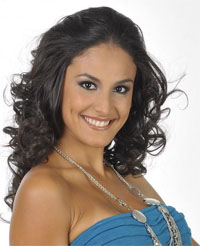
|
Miss Costa Rica, Johanna Solano, (photos left and right) made the top ten but was eliminated at the cut for the top five. Johanna is a 10 in my book (gallo pinto agrees well with some women). Of course, like any beauty pageant, the contestants have to put up with silly questions from the judges. I guess this is done so everyone is happy that a winner will use at least two syllable words during her reign. Here are a couple of the gems asked this year: "Nude beaches are common in some parts of the world. Is public nudity appropriate or inappropriate and why?" Dude, you gotta be kidding, isn't everyone in favor of more nude beaches, especially if they're populated with MU contestants? - GG "If you could change one of your physical characteristics, which one would it be and why?" Judge, amigo, clean your glasses, you should be flogged like a medieval heretic for even suggesting the possibility of a change in these ladies - GG. |
 |
|
|---|---|---|---|
 |
 |
Our hero intends to investigate what qualifications and credentials are required to be a judge at the MU pageant. I'd be willing to carve out a few days from my busy schedule if they need me. As a judge I would also suggest better questions like, "What are you doing for lunch, muchacha?.
Pan American Gold
When you're a country smaller than West Virginia with a population less than South Carolina you don't often bring home the gold competing against the giants of the world. But sometimes it does happen and a fellow named Nery Brenes recently did it.
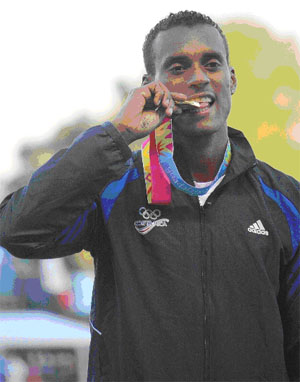 |
|---|
Costa Rica's Nery Brenes Testing the Gold |
So it was with great pride that Costa Ricans watched their boy Brenes win a Gold Medal for the 400 meter competition at the Pan American Games in Guadalajara, Mexico. This was the first time a Costa Rican has taken home a gold in these games since Sylvia Poll won in Havana in 1991.
Born Nery Antonio Brenes Cárdenas, this 26 year old hails from the industrial port town of Limon on the caribbean coast. Brenes has competed in a number of international sporting events and has placed first in at least five events including the 200 and 400 meter sprints in places like Columbia, Spain and Puerto Rico in addition to this year in Mexico.
I found the following report from the BBC News Service of special interest:
"Nery struggled for years to get the funding to race professionally and to make the best of his talent. He almost gave up the sport so he could get a job to support his family. The government finally stepped in to give him a grant, and now he has several private sponsors.
'It's so hard here. To get money, you need to be a superstar or something', he said.
When Nery came fourth in the World Indoor Championships in Valencia in March this year [2010 - ed.], he gave his $8,000 prize money to deprived families from Limon.
'Along with being world champion, and to help my family, my dream is to build a school here for poor children', he said."
In my mind that kind of thinking not only makes him a winner but, indeed, a real champion.
Super Mas Rules!
Dead center in the heart of the Quepos Metroplex (I told you our hero has delusions of grandeur), across from the bus station and central market, is a "supermarket" known as Super Mas.
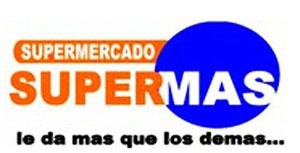 |
|---|
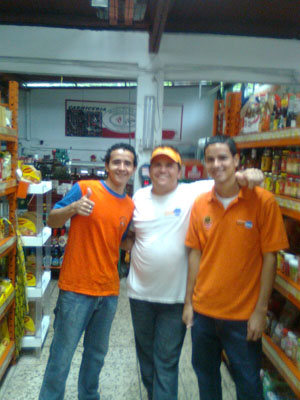 |
Some Super Mas Staff Dudes - Left Jonathan ("Pito"), Center Alex, Right Carlos |
Now by norteamericano standards, Super Mas is only about 50% larger than a standard size 7-Eleven®. But my, oh my, how they can pack a large number of items into that limited shelf space. The tag line on their logo is "...le da mas que los demas" or "...we give you more than the others". For a large number of products found there, even though there may be only one or two rows of a particular product on the shelves, it's likely to be the only one or two rows of the stuff anywhere in the area.
I confess here that I worked in an A&P for six years in high school and through half of undergraduate college and I have subconsciously evaluated every supermarket I've walked into ever since. This one is well run and caters to a definite market, the gringos; and the gringos love it (this one does for sure). At any given time it seems that about half the shoppers are gringos and/or non-natives.
This is not to say all this variety is inexpensive, it often isn't. Any imported item, despite Costa Rica being a member of CAFTA (Central American Free Trade Association), is still subject to stiff import tariffs. Prices on these items can be two to three times the same item in the U.S. People who visit Panama, where there are no tariffs, routinely report prices there are 2/3 to 1/2 of Costa Rican prices on many items.
I think I found the ultimate example of price extreme the other day while perusing the aisles at Super Mas. Offered: a 16 oz bottle of pure Vermont maple syrup; price - 17,700 colones (about $35). I passed over it because, if I bought it, I would feel obligated to pour it over something other than pancakes, like lobster-stuffed veal roast. A similar sized bottle of pure maple syrup can be bought online for $9 plus (U.S.) shipping.
The best prices in our small town on the vast bulk of standard products are to be found at our new Maxi-Pali on the outskirts of town. But If you don't have a car the only option to get there and have to take a taxi as the new store is not yet on a bus route. I used a taxi the last time but this cuts into the savings difference over Super Mas dramatically. Super Mas on the other hand is four blocks from my apartment, an easy jaunt. But basically I just like the variety of special and odd stuff available at the smaller store. I also enjoy the banter I always have with the employees.
The staff at Super Mas consists of around 8-10 "compañeros", mostly in their late teens or early twenties. They have always been friendly and helpful and, after three years, we've moved beyond the acquaintance stage to the amigo stage. One of them in the early days, I forget which one, started calling me "Bob esponga" or Sponge Bob and it stuck. Now I get called out all over town by these guys. "Hola, Bob esponga, como estas amigo?".
The picture above left shows three of the staff. Jonathan (aka "Pito") is the current produce manager, Alex is the meat manager and Carlos, the newest of them, works groceries. I use the titles loosely as people change jobs and responsibilities when the need arises, just like we used to do in the early, smaller A&P's.
I get a flashback to when I was a "yoot" (ease up GG, nostalgia isn't what it used to be) working at the A & P. We wore a white apron, white shirt, black chinos and black bow tie (snap-on of course). We all routinely worked the cash register, groceries, produce, and dairy (huge wheels of New York sharp cheddar cheese and freshly ground coffee - yum). I was even a meat cutter for a short period, though we often had to use my cuts to make hamburger.
Alex has a helper named Andre who also plays futbol at the arena near where I live. He's a pretty darn good portero (goalie). Pito also plays sometimes on the same team as Andre. I'm trying to convince some of the others to play also so we can form a team composed of and (I hope) sponsored by Super Mas.
I love this small town stuff. Pura Vida!
Christmas in Costa Rica
December is a very special month in Costa Rica. Invierno (winter or the rainy season) is replaced by verano (summer or the dry season). There is no fall or spring. The six-month long rainy season ends, the hot, muggy, wet, weather is replaced by hot dry days that are just incredible at the beach.
All working adults receive their aquinaldo in December from their employer. This is a bonus required by law and is equal to one month's pay, the thirteenth month just in time for Navidad or Christmas. And Navidad brings on a myriad of festivals, parades, and Christmas traditions. It's time for mucha fiesta. Many Ticos take vacation at this time of year to take advantage of all the fiestas. The beaches on the Pacific Coast become as crowded as they will be all year. On Manuel Antonio beach it has been even more crowded for the last couple of years as the travel time has been cut by 45 minutes as a result of the new Autopista.
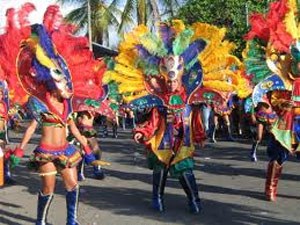 |
|---|
El Carnaval |
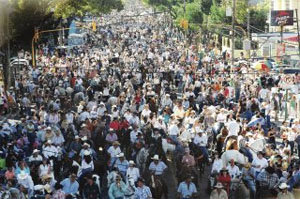 |
El Tope - Often More Than 3,000 Horses |
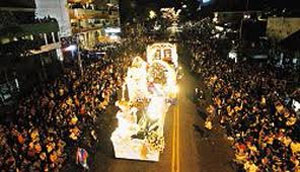 |
El Desfile de Luces |
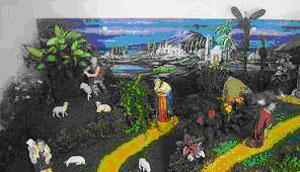 |
"El Portal" -
Constructed with Plants etc. |
|
There are three main parades in San José during the Christmas season which begins officially on December 16th:.
El Carnaval - Dancers and musical groups from all over the country compete for the best of show in costumes, dancing talent, and music.
El Tope - A Parade of showy horses, beautiful horse drawn carriages, and famous hand painted ox carts (Las Carretas). Originally these carts were pulled by people until 1840 when the exporting of coffee exploded. The carts were then pulled by oxen; transporting coffee to the ports and returning with other goods. Decorating the carts began in the early 1900's. The San Jose Tope includes floats, clowns, and marching bands.
El Desfile de Luces - A night time parade made beautiful with thousands of Christmas candles and other lights.
Christmas Traditions in Costa Rica
Christmas traditions in Costa Rica began when Christmas was first celebrated here in 1601, a few years before the founding of the first permanent settlement in Gringoland (Jamestown, 1607). Then governor, Don Vasquez de Coronado, organized the festivities and declared it a national holiday. The activity during the Christmas season is centered on the Christ child.
Like much of the Spanish speaking world, Ticos hold posadas the nine days before Christmas. Groups of children and neighbors. A“posada” consists of a group of children and neighbors getting together at a different neighbor’s house each day to act out the pilgrimage of Joseph and Mary to Bethlehem, looking for a place to stay where Jesus could be born. They say prayers, sing Christmas carols and have candies for the children at the end. Four of the children dress up as Joseph, Mary, the Angel and the Star. The rest are shepherds or “pastorcitos” (little shepherds).
Another important tradition is the construction of La Portal (the manger). For the more elaborate ones, like inside the local church, children collect plants, mosses, grasses, twigs, and sawdust to decorate it. Portals may be completed with crafted wood, statues of Mary, Joseph, The Three Kings,and the shepherds and their sheep. The simpler ones, some even plastic, blossom in many yards and patios. On Noche Buena Christmas Eve, The Christ child is placed in the manger just before the family attends Midnight Mass (Misa del Gallo).
A few days before Christmas, the Christmas tree is placed in the home. It is painted white and may be a small Cyprus tree or dried branches from the coffee plant. It is decorated small figurines, lace ornaments and brightly colored strips of paper. The gold star of Bethlehem crowns the tree. The night before Christmas some Tico children will place their shoes out for the Christ child to fill with treats and small gifts. On Christmas morning, those children are asked, "What did the Baby bring you."
Another strong tradition of the Christmas season is the Toros a laTica "bullfights". Dozens of young men (some inebriated) will hop into the local arena and torment the hell out of the bull until in runs around in a daze. The bulls are never harmed and, occasionally but not often, there is a goring. More on these fights here: BAITING THE BULL.
And, of course, there are the food traditions. A simple country stew of potatoes and spicy sausage (recipe left) is one of them. Christmas Eve dinner is a late night affair with special Costa Rican tamales that take many hours to properly prepare. Pupusas, tortillas made with many ingredients, grilled pork or chicken, as well as empanadas are served. The feast is traditionally topped off with fresh grapes and apples.
Christmas traditions in Costa Rica end with the celebration of the Feast of the Epiphany on January 6th. The night before, most Tico children greatly anticipate the arrival of The Three Kings, who will bring them gifts while they sleep. The children set out boxes of grass for the camels of the Los Reyes Magio. On the Epiphany itself, neighbors gather to pray and enjoy company with feasting and caroling. Pura Vida!
¡Feliz Navidad a Mi Familia y Todos Mi Amigos!
Prowling in Panama
After the rejection of my first application for residency described in the October edition entitled GULLIBLE TRAVELS I had to revert to the 90 day visa renewal procedure for "tourists". I hadn't done this for a year based on the (wrong) advice given to me by my intermediary in San José, the one I subsequently fired.
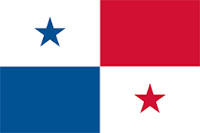 |
|---|
The Flag of Panama |
A non-resident is required to leave the country a maximum of every ninety days to get a new visa stamp on the passport. I long ago gave up debating the logic of sending people out of the country for three days to spend their money in another country just to re-enter like you were coming back for another visit. When the law changed last year we were supposed to be able to avoid this inconvenience by paying the government $100 a quarter while waiting for the cédula to issue. They never got the new policy off the ground, however, reverting to the old policy quickly. Whatever shines your colones guys.
So GG's ninety days were to be up in early November and our hero needed to make a trek into some other country. The cheapest and easiest way to do this is to run by car or bus north to Nicaragua or south to Panama. The first time I had done this was almost three years ago when a friend and I had gone to Panama with a gringo who was a seasoned veteran of this process. At that time we drove to the border where our leader dropped off his car to be repaired while we proceeded into Panama. From the Panamanian side of the border. we then went by bus to David (Dah-veed), a fairly large city located about 30 kilometers south of the frontier.
This time I had heard that there was a bus, a "Ticabus" that was the newest and most comfortable available and that now there was one that operated between San José and Panama City, passing through both Quepos and David. Why, I could just get picked up in Quepos and re-deposited here later - muy conveniente amigo. correcto? Not really, as we'll see, but I bought the round trip ticket anyway ($88). I then learned that the Quepos pick-up was at the gas station north of the town on the main highway. I was to be there at 12 AM! (that's midnight even in Rio Linda). I made it there on time by taxi but the bus showed up at ten minutes to two. Yes, Dorothy it still takes three hours to drive from San José to Quepos, even if you're a Ticabus.
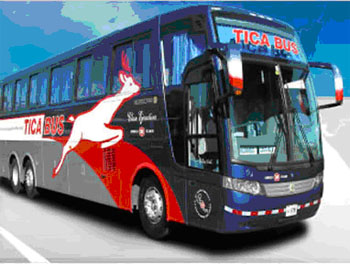 |
|---|
The Ticabus |
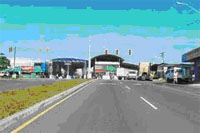 |
La Frontera (Border) on the Costa Rican Side |
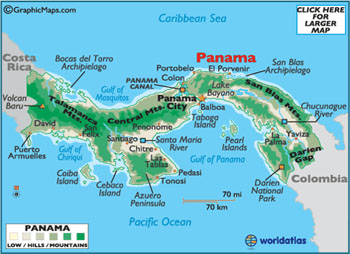 |
Panama - Note How it Runs East/West
Not North/South. David is Far Left Near the Border with Costa Rica |
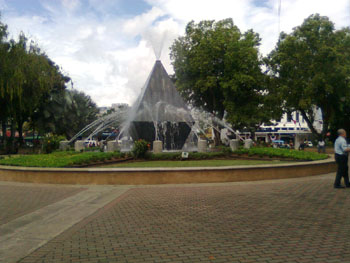 |
Central Park in David, Panama |
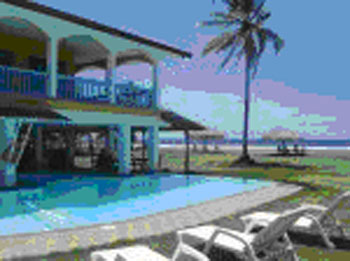 |
Las Lajas Resort on the Beach |
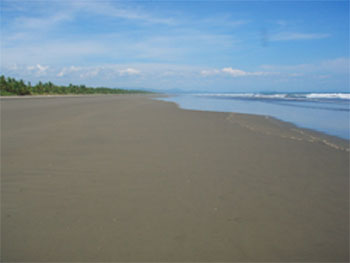 |
Playa Las Lajas South of David |
There is no real bus stop at the gas station; one must stand at the edge of the road, even in the rain. The guys at the gas station felt sorry for me and gave me an umbrella since it was raining and told me to just lay it on the side of the road when I got on the bus.
When I did get on the bus, the driver opened the cabin door behind the driver's area for me at the same time turning on the cabin light. I was immediately hit with a blast of cold air and when I scanned the cabin I saw what appeared to be a collection of zombies with no faces. All the passengers were bundled up in sweatshirts with hoods or multiple blankets they had had the foresight to bring.
I soon found out why when I was ushered to a seat by the attendant and found a small, thin blanket and tiny pillow on the seat. The AC was on so strongly that, despite the blanket, I froze my pelotas off all the way down to the border which we reached in 3 hours flat, at 10 minutes to five AM.
My hopes that we would get a jump on the day were dashed when we found out that the Costa Rican passport control office didn't open until 6, so we stood on line for an hour in the dark. Once open, that part of the process was fairly quick. We then marched the 100 meters or so down to the Panamanian check-in.
Panamanian passport control and customs took another two hours both because the process is slow and also because all luggage from the bus had to be unloaded and then reloaded at one time. We left the border at 8:30, three and a half hours after we arrived.
On the short 45 minute run down to David, Ticabus offered us a sandwich and a cup of coffee or juice. By that time most of the passengers, who were mostly from San José, were ready to eat road kill and devoured the simple offering. So did I.
In David, I was dumped, ...er deposited at a shopping center outside of town. This shopping center had a Rey Supermarket, a market I had sampled on my first trip there a few years ago. For someone who has limited shopping experiences available to him these days, walking into Rey is a semi-orgasmic experience. They're just like U.S. markets (Publix, for example) with low, low prices I stayed about 45 minutes ogling the shelves,
David is a city of about 120,000 to 150,000 depending on who is reporting the figure and how much of the environs are included. The town is in the province of Chiriqui, the name of a extinct volcano not far from the town.
I stayed at the Hotel Iris located right on the center square, handy to the shopping district and many restaurants. The hotel doesn't have a restaurant but there are several on or near the square that offer cafeteria style buffets.
The currency in Panama is the U.S. Dollar although there are some bimetallic coins called Bolivars which are in denominations of $1. There are also Bolivar quarters, dimes and nickels which are exactly equal in value to their U.S. counterparts.
Because I didn't get the dates straight, I ended up staying four nights at the Iris. The room was small but comfortable with A/C, TV and a shower with hot and cold water (not always the case in some Central American hotels). Bill for four nights: $132 including taxes. Taxis are cheap, $1.50 to $2 will get you almost anywhere around town. Besides the hotel bill, I had difficulty spending $100 over the four days.
The hotel charges only $1 an hour for internet use. I was having trouble finding the "@" sign on their Spanish keyboard. The two middle-aged ladies at the front desk couldn't figure it out either. So I simply went out the front door and tapped the first teenager I could find on the shoulder and dragged him into the hotel. In a flash he came up with "ctrl-alt-Q" and I had my "@".
I went to an Italian restaurant suggested by the hotel one night and had a cheesy-cream soup with shrimp, a chicken breast stuffed with mushrooms and mozzarella in a white sauce, two large scoops of ice cream for desert and a coke. My guess from the prices on the menu was that the bill would come to $17, but before I got the bill, the cashier came over and helped me fill out a form that got me a senior discount of 25%. Total for the bill with taxes: $13. OLd farts rule in Panama.
On Sunday I found a bus at the main station about five blocks from the hotel and went to a beach that had been recommended by a local gringo: Las Lajas. Of course the dude who recommended it was the owner of the Las Lajas Resort and failed to tell me it was 75 kilometers south to San Felix and then 10 more to the beach by taxi, a good one and a half hour trip in total.
I spent a pleasant day there walking the beach and grabbing some rays. Playa Las Lajas reminds me of Playa Palo Seco near the town of Parrita just north of Quepos. Long stretches of smooth sand, people miles apart and water I deemed too rough and dangerous for an anciano (old fart) to swim in. The next time I want to make sure to investigate the beaches directly west of David (the country runs pretty much east and west - see map above).
So, David, Panama offers a pleasant and interesting journey at a very reasonable outlay of expenses. But amigos, I would avoid the Ticabus to Panama unless you enjoy being without sleep for two nights (they wanted me at the bus stop at 3:30 AM to catch the return) and also enjoy testing the limits of human endurance in an overly air conditioned environment.
Pura Panama! Nah, it just doesn't ring like Pura Vida!
What's-in-a-Word
Bocas y Tapas
Interestingly enough, neither of these words appears, in the plural form, in my (pocket size) Oceano Dictionary or handy-dandy, often erroneous, on line translator.
| There are Bocas... |
|---|
 |
... and Other Bocas... |
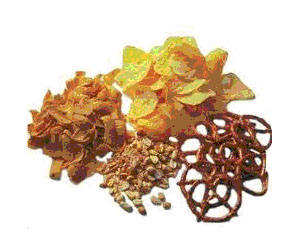 |
... and Then There are Tapas (Yummers) |
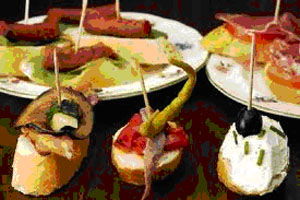 |
Boca, of course, is the Spanish word for mouth. For example, there are the towns in Florida called Boca Raton (Rat's Mouth - OK, maybe it's only mouse's mouth) or Boca Grande (Large Mouth) or the set of islands just off the caribbean coast of Panama called Bocas del Toro (Bull Mouths).
Boca is also commonly used to describe a small port or the mouth of a river. In the town of Quepos, there is a neighborhood called Boca Vieja or the "Old Port" which encompasses the river exiting Quepos to the sea. The docks are still widely used by commercial fishermen and the region contains a major fish processing plant.
While Bocas and Tapas both generally refer to things that fall into the snack category, bocas tend to be a simpler type of snack such as potato chips, pretzels or peanuts. Also, bits of cheese and salami served in bite-sized portions ("pinchos") would more likely be called bocas than tapas.
I'm told by my Spanish teacher that the use of tapas for snacks came from Spain and, though widely used in most Spanish speaking countries, was slow to be adopted in Costa Rica. The Ticos originally preferred to call all snacks of this type bocas. But in recent decades the word has begun to sprout in many places and is now seen here on many bar and restaurant advertisements.
Tapa also is the word for lid or jar cover. But when used in the pertinent context here for snacks, is often a somewhat more substantial snack requiring more preparation then a boca. Tapas are often served warm or hot and therefore are closer to hors d'oeuvres than snacks.
There are several bar/restaurants to be found in the Quepos/Manuel Antonio area offering tapas. One of the more interesting ones was pointed out in the March 2009 issue (TAPAS AT SUNSET). The view at this well known restaurant is spectacular if you arrive around 5 PM. Remember, the views in Manuel Antonio disappear a little early, like at between 5:30 and 6 PM.
Buen provecho, amigos!
ROMEO Corner
(Retired Old Men Eating Out)
Jungle Juice - Quepos
NOTE (Update - December 2012): The Jungle Juice fruit and juice bar has moved to a new location in the strip mall in Manuel Antonio half way between Super Joseth supermarket and the football field on the main road.
Location: On the main Quepos street running towards Manuel Antonio (Identified on the GGC
MAP as the Avenida de Las Palmas) across from the Escuela de La Republica de Corea
Hours: 8 AM to 8 PM Everyday
Parking: Usually ample on the main street (park close to the curb as this is the main bus route).
Contact: Tel: 2777-7328
Reviewing ROMEOS: Brian M., Bob N. Anheidy M.
So healthy food has to be either bad tasting or boring, right? Not.
Jungle Juice is proving the opposite. This juice bar is brand new to Quepos and situated in the building and quarters where the former Joker Pizza was housed.
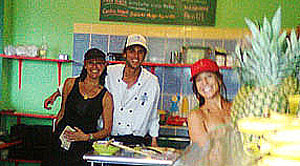 |
The Three Partners at Jungle Juice Dina (Left), Chris and Maria |
There are two food bars with several seats each as well as two tables nearby. You don't expect velvet drapes and silver service at a juice bar; that's not the nature of the beast. What you do have at Jungle Juice is a bright, clean and colorfully attractive place to enjoy a refreshing drink or a light lunch.The place is decorated with tile work and walls in several earthen colors making it peaceful, relaxing and a bit caribbean.
The food and drink offering capitalizes on the myriad of fresh fruits and vegetables available in this area and offers some of the most interesting drink concoctions and smoothies this ROMEO has seen anywhere. You can choose from just great tasting fruit smoothies or from the ultra healthy (but still great tasting) ones. Here are some examples of the smoothies offered:
The Green Turtle (lemonade, mint, ginger, honey); The Funkey Monkey (banana, chocolate, mint, avocado), The Diuretic (apple, pineapple, papaya); The Circulation (orange, lemon, cucumber, banana, ginger); The Liver Helper (beet, coconut, cucumber, carrot - I loved that one - GG); The Cardio (Banana, Mango, Avocado). , and the Pure Detox Juice (beet, carrot, celery, parsley, ginger, orange). And there are many more to choose from.
In addition to these and the others on the menu board, Jungle Juice will prepare any custom combination you may fancy. |
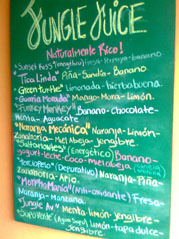 |
|---|
Besides smoothies, the Juice offers freshly made crepes with interesting ingredients, for example:: The Medi-Tico (hummus, palm heart, yogurt, cheese) or the The Órale (cheese, refried beans, guacamole, salsa, yogurt).
The staff was very friendly, courteous and prompt. Dina, la patrona, is a devotee of health food and follows a healthy lifestyle, often participating in decathlons and riding her bike or walking from home which is several miles from her work.Perhaps this is the real meaning of Pura Vida! that we should all try to emulate.
For atmosphere, food quality and service we have to give Jungle Juice four sloths.
Smoothies are priced at 1,000 and 1,500 colones ($2-3) and the crepes run 1,500 to 2,500 ($3-5). This puts Jungle Juice in the bargain range for this area and that fact, combined with the four sloth rating, makes Jungle Juice a high value.
So if you need a picker-upper, a lunch treat or a snack, and want to stay healthy at the same time, you can't go wrong at Jungle Juice.
Founder's Quotes
Tom Jefferson on Lawyers in Congress:
"If the present Congress (circa 1790 - ed.) errs in too much talking, how can it be otherwise in a body to which the people send 150 lawyers, whose trade it is to question everything, yield nothing, & talk by the hour? That 150 lawyers should do business together ought not to be expected." --Thomas Jefferson, Autobiography, 1821
Currently, Congress is about 40% lawyers, 54% of the Senate (54) and 36% of the House (156).
And from Madison, one great reason why politicians need to be restrained by the Constitution:
“Enlightened statesmen will not always be at the helm." -- James Madison
Don Roberto de Quepos, El Gringo Dorado Pura Vida! |
Be pithy but kind. I'm sensitive. |
|---|





